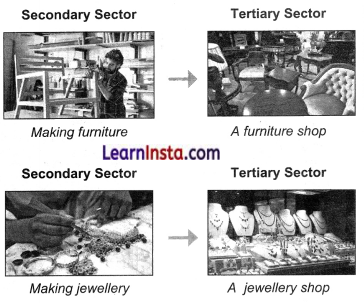Chapter-wise Exploring Society India and Beyond Class 6 Solutions and Class 6 Social Science SST Chapter 14 Economic Activities Around Us Question Answer NCERT Solutions are useful for focused study.
Economic Activities Around Us NCERT Class 6th SST Chapter 14 Question Answer
Economic Activities Around Us Class 6 Questions and Answers
The Big Questions (Page 195)
Question 1.
How are economic activities classified?
Answer:
Economic activities are classified based on similar characteristics. Some activities depend on nature, some activities transform raw materials into final products and some others provide services to all producers in an economy.
Question 2.
What differentiates these activities to be grouped into sectors?
Answer:
Economic activities are grouped into sectors based on their functions and the type of work involved. Primary activities focus on obtaining natural resources, secondary activities are about manufacturing goods, and tertiary activities provide services that support both the primary and secondary sectors.
![]()
Question 3.
How are the three sectors interconnected?
Answer:
The three sectors are interconnected as follows: The primary sector supplies raw materials (e.g., farming), the secondary sector processes these materials into goods (e.g., manufacturing), and the tertiary sector provides services (e.g., transportation) to distribute these goods to consumers. Each sector relies on the others to function smoothly.
Let’s Explore
Question 1.
Now that we have seen some examples of secondary sector activities, can you name two more economic activities in the secondary sector? (Page 200)
Answer:
- Textile industry
- Handicraft manufacturing unit
Question 2.
Label the pictures in the illustration shown in Fig. 14.1 on page 206 as:
1. Primary sector
2. Secondary sector
3. Tertiary sector
Answer:
Label the Pictures:
- Primary Sector: Activities like farming or mining.
- Secondary Sector: Processes such as manufacturing or construction.
- Tertiary Sector: Services including retail or transportation.
Questions, Activities and Projects (Page 208)
Question 1.
What is the primary sector? How is it different from the secondary sector? Give two examples.
Answer:
The economic activities in which people directly extract raw materials from nature are the primary sector of the economy.
The secondary activities deal with the mannfacturing of goods from the outputs of primary activities, while in primary activities produce is extracted from nature. Examples of primary sector activities are as follows
- Cultivation of grains is an example of a primary activity while making flour at a mill is a secondary activity.
- Extracting iron from mine is a primary activity while using lron in automobles ls an example of secondary activity.
Question 2.
How does the secondary sector depend on the tertiary sector? Illustrate with a few examples.
Answer:
In the secondary sector, the products are made into consumable items, which is then distributed by the
tertiary sector. For example,

![]()
Question 3.
Glve an example of interdependence between primary, secondary and tertiary sectors. Show it using a flow diagram.
Answer:
Primary, secondary and tertiary sectors are interdependent in the following ways
- Primary Sector The process of cultivation, requires tractors, seeds, fertilisers etc. that are produced by the secondary sector activities.
- Secondary Sector Secondary sector activities are dependent on primary activities for raw materials and tertiary sector for marketing, research, finances and transportation.
- Tertiary Sector The tertiary sector does not produce any goods. It complements the other two sectors, hence dependent on them.


Class 6 Social Science Question Answer
- Chapter 1 Locating Places on the Earth
- Chapter 2 Oceans and Continents
- Chapter 3 Landforms and Life
- Chapter 4 Timeline and Sources of History
- Chapter 5 India, That is Bharat
- Chapter 6 The Beginnings of Indian Civilisation
- Chapter 7 India’s Cultural Roots
- Chapter 8 Unity in Diversity, or ‘Many in the One’
- Chapter 9 Family and Community
- Chapter 10 Grassroots Democracy Part 1 Governance
- Chapter 11 Grassroots Democracy Part 2 Local Government in Rural Areas
- Chapter 12 Grassroots Democracy Part 3 Local Government in Urban Areas
- Chapter 13 The Value of Work
- Chapter 14 Economic Activities Around Us